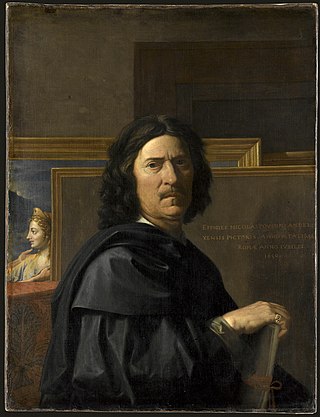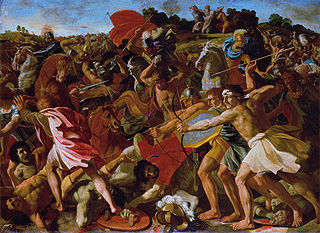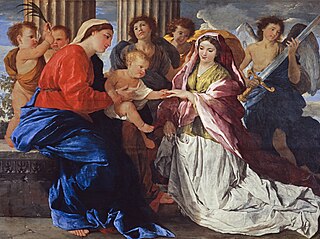
Baroque painting is the painting associated with the Baroque cultural movement. The movement is often identified with Absolutism, the Counter Reformation and Catholic Revival, but the existence of important Baroque art and architecture in non-absolutist and Protestant states throughout Western Europe underscores its widespread popularity.

Nicolas Poussin was a French painter who was a leading painter of the classical French Baroque style, although he spent most of his working life in Rome. Most of his works were on religious and mythological subjects painted for a small group of Italian and French collectors. He returned to Paris for a brief period to serve as First Painter to the King under Louis XIII and Cardinal Richelieu, but soon returned to Rome and resumed his more traditional themes. In his later years he gave growing prominence to the landscape in his paintings. His work is characterized by clarity, logic, and order, and favors line over color. Until the 20th century he remained a major inspiration for such classically-oriented artists as Jacques-Louis David, Jean-Auguste-Dominique Ingres and Paul Cézanne.

The National Gallery of Victoria, popularly known as the NGV, is an art museum in Melbourne, Victoria, Australia. Founded in 1861, it is Australia's oldest and most visited art museum.

Gaspard Dughet, also known as Gaspard Poussin, was a French painter born in Rome.

Cassiano dal Pozzo was an Italian scholar and patron of arts. The secretary of Cardinal Francesco Barberini, he was an antiquary in the classicizing circle of Rome, and a long-term friend and patron of Nicolas Poussin, whom he supported from his earliest arrival in Rome: Poussin in a letter declared that he was "a disciple of the house and the museum of cavaliere dal Pozzo." A doctor with interests in the proto-science of alchemy, a correspondent of major figures like Galileo, a collector of books and master drawings, dal Pozzo was a node in the network of European scientific figures.
Events from the year 1634 in art.
Aubrey Hickes Lawson Gibson was an Australian businessman, arts patron and art collector. Born and educated in Melbourne, Gibson became a successful businessman in the city, establishing his own company, A.H. Gibson Industries, which was listed on the stock exchange in the 1950s. He was also a director of other major manufacturers and distributors, including Volkswagen Australasia and Hoover Australia.

The National Gallery is the primary British national public art gallery, sited on Trafalgar Square, in central London. It is home to one of the world's greatest collections of Western European paintings. Founded in 1824, from an initial purchase of 36 paintings by the British Government, its collections have since grown to about 2,300 paintings by roughly 750 artists dating from the mid-13th century to 1900, most of which are on display. This page lists some of the highlights of the collection.
Ursula Hoff was an Australian scholar and prolific author on art. She enjoyed a long career at the National Gallery of Victoria in Melbourne, where she was deputy director from 1968 to 1973. Her involvement then continued when she was appointed London Adviser of the Felton Bequest (1975–83), a major charitable foundation dedicated to the NGV.

Abraham de Vries was a Dutch painter who was one of the leading portraitists of his age. As he led a peripatetic lifestyle and worked in France, Antwerp and the Dutch Republic his stylistic qualities are difficult to pin down.

The Seven Sacraments refers to two series of paintings of the seven sacraments by the French painter Nicolas Poussin.

The Adoration of the Golden Calf is a painting by Nicolas Poussin, produced between 1633 and 1634. It depicts the adoration of the golden calf by the Israelites, from chapter 32 of the Book of Exodus. It was made as part of a pair of paintings commissioned by Amadeo dal Pozzo, Marchese di Voghera of Turin, a cousin to Cassiano dal Pozzo, Poussin's main sponsor in Rome. By 1685 the pair had passed to the Chevalier de Lorraine and in 1710 they were bought by Benigne de Ragois de Bretonvillers. In 1741 they were bought from Samuel by Sir Jacob Bouverie, whose son William became the first Earl of Radnor. The Earls of Radnor owned the pair from then until 1945, when it was split for the first time and The Adoration of the Golden Calf bought by the National Gallery in London for £10,000, half of which was contributed by the Art Fund. It now hangs in Room 19 of the National Gallery, where it and Poussin's The Adoration of the Shepherds were vandalised with red spray paint on 17 July 2011. The French-speaking vandal covered up most of the nude figures.

Extreme Unction is one of a set of seven scenes representing the sacraments of the Catholic Church, painted between 1638 and 1640 by the French artist Nicolas Poussin (1594–1665).

The Adoration of the Shepherds is a painting of 1633–34 by the French painter Nicolas Poussin (1594–1665), now in the National Gallery, London. It is in oils on canvas, and measures 97.2 by 74 centimetres. Unusually for Poussin, it is signed "N. Pusin.fe" ["fecit"] on the stone at lower right. By 1637, soon after it was painted, it was owned by Cardinal Gian Carlo de' Medici (1611–1663), the second son of Grand Duke Cosimo II of Tuscany and was placed in his villa outside Florence.

Giovanni Andrea Podestà or Giovanni Andrea Podesta was an Italian painter and engraver who was principally active in Rome. His principal subject matter is children playing in landscapes with classical objects. His works show the influence of Poussin's Arcadian landscapes and bacchanals, which were ultimately derived from Titian's bacchanals.
Margaret Mary Manion is an Australian art historian and curator recognised internationally for her scholarship on the art of the illuminated manuscript. She has published on Medieval and Renaissance liturgical and devotional works, in particular, on Books of Hours – the Wharncliffe Hours, the Aspremont-Kievraing Hours, the Très Riches Heures. She was instrumental in cataloguing Medieval and Renaissance illuminated manuscripts in Australian and New Zealand collections. She was Herald Chair Professor of Fine Arts at the University of Melbourne from 1979 to 1995, also serving as Deputy Dean and Acting Dean in the Faculty of Arts, Associate Dean for Research, Pro-Vice-Chancellor from 1985 to 1988, and in 1987, the first woman to chair the University's Academic Board.
Pamela is a series of twelve paintings by the English artist Joseph Highmore, produced between 1741 and 1743 as the basis for a set of prints. They are free adaptations of scenes from the novel Pamela, or Virtue Rewarded by Samuel Richardson. They are now divided equally between the National Gallery of Victoria, the Fitzwilliam Museum and Tate Britain.

The Battle between the Israelites and the Amorites, Joshua's Battle Against the Amorites or Joshua's Victory over the Amorites is a c. 1625 oil-on-canvas painting by the French artist Nicolas Poussin, now in the Pushkin Museum, in Moscow.

Joshua's Battle Against the Amalekites or Joshua's Victory over the Amalekites is a c. 1625 oil-on-canvas painting by the French artist Nicolas Poussin, now in the Hermitage Museum in Saint Petersburg.

The Mystic Marriage of Saint Catherine is an oil on panel painting by Nicolas Poussin, dated to about 1628–1629, which depicts the mystical marriage of Saint Catherine to Christ. The picture is now in the Scottish National Gallery, Edinburgh.















